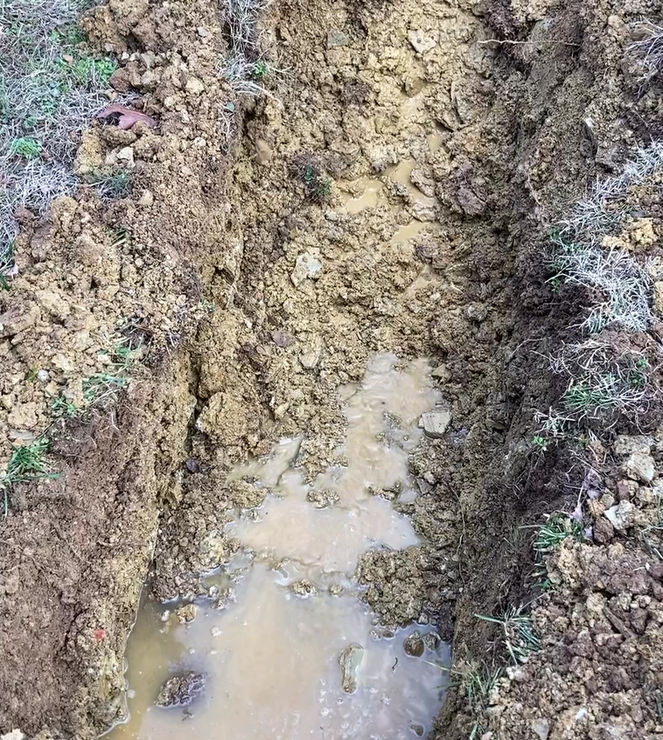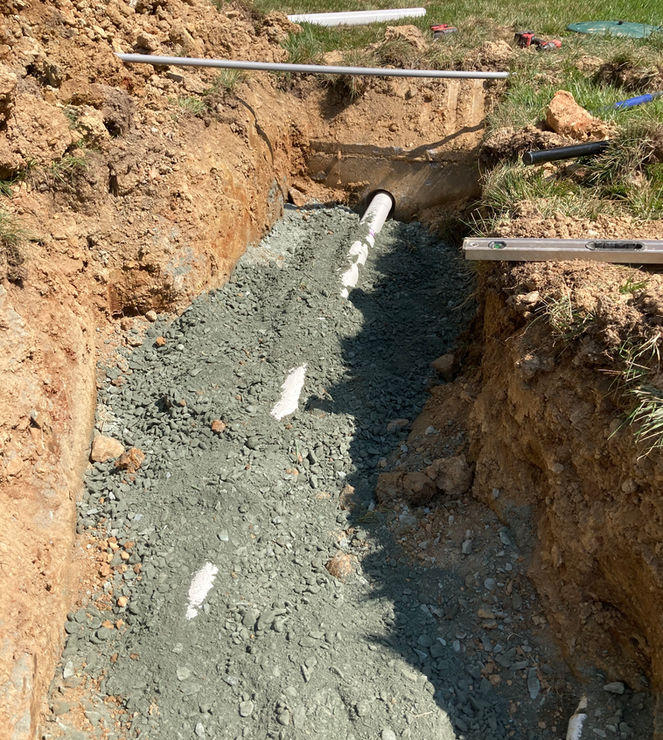
French Drain
This is your basic French Drain situation. This was a 4 bedroom house with a 1500 gallon septic tank, Aqua Safe 600, 1500 Pump Tank, and American Automatic Drip Package. The tanks were together at the bottom of a mounded-up paved driveway. Surface water was coming off the impermeable driveway and going across the tanks. An open ditch pipe that collected water from the street above was also getting discharged above the tanks. The homeowner would get alarm conditions during rain events because of the surface water and subsurface lateral water movement would seep around the previously excavated dirt around the tanks and infiltrate the mid-seam pump tank. This would cause the ¾” disc filters in the headworks to become clogged from the silt that the infiltrating water brought, causing the pump tank water level to rise to high-water alarm conditions.
To mitigate the surface water and lateral subsurface water inundating the pump tank (and potentially the other tanks), we installed a french drain approximately 18” in the ground around the tanks. This moved the water around the tanks and to an area where the extra water would not impact the system.
Dry Well
This was a fun job. This house had an elevated sand mound for their septic system that utilized drip irrigation and a 1” manual headworks. The 1” vortex filter would get clogged every year during the late winter/early spring season, causing an alarm condition. The problem was the concrete pump tank had a mid-seam and was letting groundwater in, which would make the pump run non-stop and clog the vortex filter up prematurely with silt from the infiltrating groundwater. The groundwater was coming from an underground wet weather spring that flowed heavily during the wet season. The Norweco treatment tank and pump tank were also in a poor landscape position (i.e. in a bowl) that would not allow for positive drainage.
We decided to go with a dry well (wiki) around the Norweco and pump tanks along with a drainage line to help collect the groundwater. We then installed a sump pump that transferred the groundwater away from the tanks into an area that could receive positive drainage. Hydrology is so cool.
Deep D-Box
This customer had sewage starting to back up in their house. The problem came from a buildup of sludge (not biomat) in the drainfield. The D-box for the system ended up being approximately 4’ in the ground. We jetted the lines and had a pump truck vacuum out the accumulated sludge in the lines. After we reintroduced clean water into the drainfield lines, we treated the lines with Arcan (Shop Arcan). We then installed a D-Plate with a Polylok riser system so that routine annual maintenance and monitoring could be done.
Sewer Line Replacement
This is a classic case of one-thing-leads-to-another. This is a Sewer Line Replacement from the septic tank going to the pump tank. This sewer line had negative pitch going from the septic tank to the pump tank. That ment that effluent was standing 1-2” in the pipe. This was causing septic to leak out of the septic tank through the pipe penetration point into the septic tank, causing a wet spot in the yard.
That also caused septic effluent to stand 1-2” in the Sewer line coming into the septic tank from the house. That caused grease coming out of the house to cool and solidify in the pipe before the septic tank. Normally grease makes it to the septic tank in a liquid form. Once it cools, it becomes solid and floats to the top in the septic tank forming into the scum layer. Since the grease cooled in the pipe prior to the septic tank, it formed a grease blockage which made the plumbing in the house start to drain slowly.
Once we fixed the sewer line on the back-end of the septic tank, we no longer had problems with grease blockage in front of the septic tank. It is so important to take care of the small things like making sure the pitch of your pipe is positive and bedded on stone (i.e. rockdust or crush-and-run). Also make sure that your pipe penetrations into your tanks are sealed property. Groundwater infiltration into your septic systems can cause ongoing problems as well.
Large Septic Tank Replacement
Putting an access riser on a septic tank may look like a simple modification. However, we have always had problems putting access risers on some septic tanks because of their large openings. No company made an adapter ring large enough to accommodate the larger septic tank opening. That’s until we started using the D-Plate (Shop D-Plate). These adapter plates have been a game changer for us in the septic onsite field. Not only can they fit over the whole hole of any septic tanks, you can use them to install access risers onto existing d-boxes. Great little product.
Peat Moss Replacement
Some Aerobic Treatment Units utilize peat moss in-order to mechanically and biologically (i.e. aerobic bacteria) filter septic tank effluent into a secondary or advanced treatment state. Some that use peat moss are Puraflo, Ecoflo and EcoPure. After so much usage, the peat moss needs to be replaced periodically. This shows us replacing the peat moss of a Puraflo system (Puraflo Peat System). We first perform the extraction of the peat moss with a vac truck. We then clean the Puraflo pods and install the new peat moss.
14 Port D-Box
This large 14 port D-Box was found with a camera/locator about 300 ft (a football field) away for the septic tank and treatment tank. It was located in a Loblolly Pine grove with roots all in it. Two D-Plates with a Tuf-Tite Riser system allowed for continued monitoring and maintenance.
This particular septic system is located a subdivision in the Fluvanna County, VA were the lots are ½ acre and surrounded by common area (i.e. Rural Cluster Development). Drainfields are in the common area usually grouped together where there is good soil and landscape. So identifying which drainfield is with which house/lot is almost impossible without a camera with a locator. Once we found the D-box (which had significant root infiltration), we didn’t want to try and locate it again during our annual inspection. We also wanted to make sure the roots were maintained and kept under control during our annual inspection. The D-Box is an important component of the septic system and the inability to monitor and maintain it on a routine basis can lead to costly repair or replacement of the entire system.
4 Zone Drip Repair
4 Zone Drip Repair using an indexing zone valve, manual headworks and a time dose control panel.
Others





































